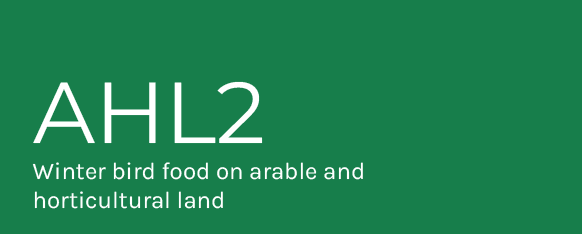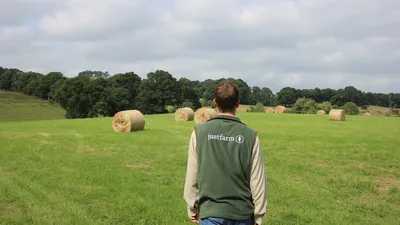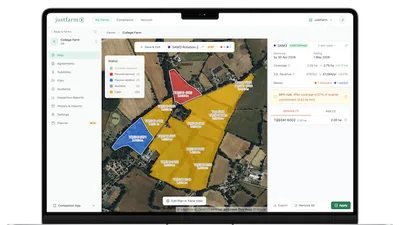AHL2 - Winter Bird Food on Arable and Horticultural Land
Payment
You’ll receive £853 per hectare per year.
Aim
This action aims to create areas of winter bird food that provide a supply of small seeds for smaller farmland birds from late autumn until late winter. The purpose of this is to:
- Provide food resources for farmland birds, especially in late autumn and winter.
- Encourage flowering plants in the summer, which will benefit insects including bumblebees, solitary bees, butterflies and hoverflies.
- Support an IPM approach if located close to cropped areas.
Where You Can Do This Action
You can do this action on eligible agricultural land located below the moorland line. The table below sets out what land is eligible for AHL2.
Table 28: Eligible land for AHL2
| Eligible land type | Eligible land use code | Compatible land cover |
|---|---|---|
| Arable land, including temporary grassland | Arable crops | Arable land |
| Leguminous and nitrogen-fixing crops | Arable land | |
| FA01 | Arable land | |
| TG01 | Arable land | |
| Permanent crops – horticultural | TC01 | Permanent crops |
The glossary (annex C) explains what we mean by land types, land use codes and compatible land covers.
The SFI application service will automatically calculate what area may be eligible for this action in each land parcel. This is called the ‘SFI available area’. You must check this area is an eligible land type. Find out how the SFI available area is calculated in the information on land that’s eligible for the SFI actions (section 4.1.2).
You can apply for this action on either the total SFI available area in each land parcel shown in your SFI application, or part of that area. However, this action is normally intended to be done on part of a land parcel as a block or strip.
For SFI applications submitted on or after 26 March 2024, this is a ‘limited area’ action. The total eligible area you enter into any combination of one or more of the ‘limited area’ actions must not be more than 25% of the total agricultural area of your farm.
Read the guidance on ‘SFI actions with an area limit’ (at the start of section 2) for more information and a list of the ‘limited area’ SFI actions.
This action is rotational. You can do this action on the same area of eligible land each year of your 3-year SFI agreement, or you can move the area each year.
Other Land Management Actions or Options You Can Do on the Same Area as AHL2
The table below sets out which other SFI actions, CS management options, ES revenue options and SFI pilot standards can be located on the same eligible area within a land parcel as AHL2.
Table 29: Actions or options that can be located on the same area within a land parcel as AHL2
| Scheme | Action or option codes that can be located on the same area as AHL2 |
|---|---|
| SFI 2023 | SAM1, IPM1, IPM3 (only if the companion crop is not present during the winter months), IPM4, NUM1 |
| CS | HS3, HS9, OR3, OR4, OR5, OT3, OT4, OT5, SW17 |
| ES | No ES revenue options |
| SFI pilot | No area-based SFI pilot standards |
Use the CS grant finder to search for the CS option codes shown above.
The SFI actions for hedgerows (HRW1, HRW2 and HRW3), CS option BE3 and the introductory level of the SFI pilot hedgerows standard can be done on the eligible boundaries of a land parcel entered into AHL2.
If an action or option cannot be located on the same area within a land parcel as AHL2, this is because it’s not an eligible land type, or the activities are incompatible, or you would be paid twice for doing the same activities on the same land. In this case, that area will be automatically removed from the affected land parcel’s SFI available area in your SFI application.
If this is the case, you may be able to do the action on a different area in the same land parcel if:
- it’s an eligible land type for the action or option
- it’s a part-parcel action or option
- the area used for the action or option does not overlap with the area used for AHL2
Read the information about eligibility of land used for other schemes and funding sources (section 4.2) to find out more.
What To Do
You must establish and maintain blocks or strips of winter bird food on land entered into this action.
To establish the winter bird food blocks or strips, you must sow a mix of at least 6 crops that will provide an extended supply of small seeds for farmland birds.
The mix you sow must not include any of the following crops, because these are not appropriate for the smaller farmland bird species this action is intended to support:
- artichokes
- reed canary grass
- giant and intermediate sorghum
- maize
- miscanthus
- sweet clover
- tic beans
If you sow an annual mix, it can include a range of cereals, brassicas or other small-seeded crops. If you sow a 2-year mix, it can also include biennial crops such as kale, stubble turnip or teasel.
Once established, you must maintain the winter bird food blocks or strips. To do this, you must manage them in a way that could reasonably be expected to achieve this action’s aim. You may need to re-sow the blocks or strips, as necessary, so they continue to produce an extended supply of small seeds.
You can maintain existing winter bird food blocks or strips to meet this action if they:
- meet the requirements explained above
- are not already being paid for under another environmental land management scheme option, such as CS option AB9 (wild bird food)
When to Do It
If you’re doing this action on the same area of land for the 3-year duration of your SFI agreement, you must:
- establish the winter bird food blocks or strips within the first 12 months of your SFI agreement
- maintain the area of winter bird food blocks or strips in each subsequent year of your 3-year SFI agreement
If you’re rotating this action around your farm, each year of your SFI agreement you must do it for a period of time that could reasonably be expected to achieve this action’s aim.
How to Do It
It’s up to you how you complete this action, as long as you do it in a way that can reasonably be expected to achieve this action’s aim.
You may find it helpful to read the voluntary guidance on how to establish and maintain winter bird food on arable and horticultural land, but you do not have to follow it.
What Evidence to Keep
You should keep evidence to show what you’ve done to complete this action. This will help if it’s not clear that you’ve completed the action in a way that could reasonably be expected to achieve this action’s aim. You must supply this evidence if we ask for it.
This evidence could include photographs and other documentation to show what you’ve done to complete this action. It could also include field operations at a land parcel level and associated invoices. If you choose to take photographs, read the guidance on how to take photographic evidence for SFI actions (annex A).
Contains public sector information licensed under the Open Government Licence v3.0. Source: SFI Handbook for the SFI 2023 Offer




